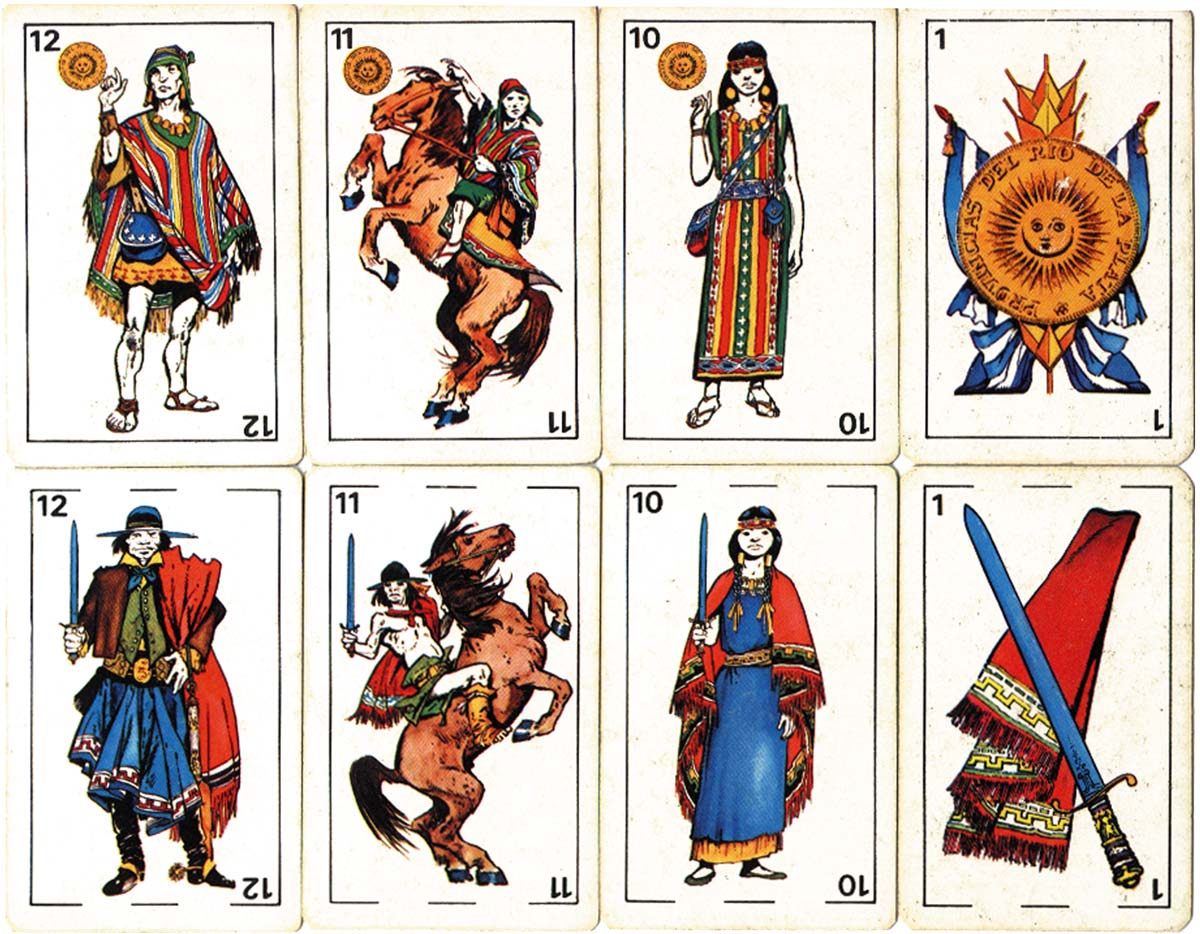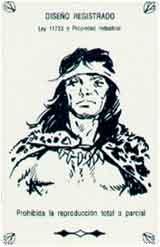Baraja Aparcero
Designed to illustrate the history of four indigenous tribes who represent the roots of the Argentinean race.
Naipes Argentinos “APARCERO©”
by Obsequios Empresarios Argentinos, Santa Fe, c.1983.

Above top: The Daiguita-Calchaquies tribe lived in the mountainous north-western area of Argentina, and were largely responsible for the fierce opposition offered to the Spaniards on their attempts to invade the territory. The ace of coins is represented by an image of the first gold coin made in Argentina, in 1813. The Ranqueles tribe (swords), descendants of the Araucanos, were the ethnic inhabitants of the pampas. They lived a hunter-gatherer lifestyle and resisted the white Europeans. They believed in a spirit of evil 'el galichu' and their beliefs were sometimes adopted by neighbouring tribes. Basket ware and weaving were their main crafts. The sword suit symbol is represented by a "facón caronero" a fighting weapon rather than a tool. The king depicts the legendary chief Mariano who liked to dress like a gaucho.



Above: Ace and courts from the suit of cups, represented by a typical piece of ethnic tribal pottery and Patagonian Indians.
Ace and courts from the suit of batons, or clubs, represented by the macana - a commonly used weapon in inter-tribal war.
The Mataco tribe depicted on the court cards were indigenous to the north of Argentina.
The leader of the tribe - number 12 - has also been featured on the Joker, giving a vague resemblance to Ché Guevara.
The example of Naipes ‘Aparcero’ was published by Obsequios Empresarios Argentinos, Buenos Aires in around 1983 for Rotativos Venus whose logo appears on the reverse. The cards are designed to illustrate the history of four indigenous tribes who represent the roots of the Argentinean race. The deck comes complete in a box, with two Jokers and an explanatory leaflet.
In early editions of this deck the typeface used for the indexes is a sans serif, as in the example shown on this page. Naipes Aparcero are currently printed by Gráfica 2001 where a seriffed typeface is used.


By Simon Wintle
Member since February 01, 1996
I am the founder of The World of Playing Cards (est. 1996), a website dedicated to the history, artistry and cultural significance of playing cards and tarot. Over the years I have researched various areas of the subject, acquired and traded collections and contributed as a committee member of the IPCS and graphics editor of The Playing-Card journal. Having lived in Chile, England, Wales, and now Spain, these experiences have shaped my work and passion for playing cards. Amongst my achievements is producing a limited-edition replica of a 17th-century English pack using woodblocks and stencils—a labour of love. Today, the World of Playing Cards is a global collaborative project, with my son Adam serving as the technical driving force behind its development. His innovative efforts have helped shape the site into the thriving hub it is today. You are warmly invited to become a contributor and share your enthusiasm.
Related Articles

Jockey Club de Buenos Aires
Spanish-suited pack by Chas Goodall & Son Ltd for the Jockey Club, Buenos Aires.

Mexican ethnic playing cards
Mexican ethnic groups depicted on playing cards by Fábrica de Naipes Cuauhtemoc.

Seminole Wars deck
Seminole Wars deck by J. Y. Humphreys, Philadelphia, c.1819.

Ubo cards
Traditional Ubo cards from the Philippines made from tree bark.

Motherpeace Round Tarot
An original and imaginative feminist tarot invoking matriarchal Goddess energy.

Colonial Art
A collection of 53 pieces of art showcasing detailed scenes from early American colonial life.

Le jeu des 7 Familles ’Utuafare
Colourful Happy Families game from Tahiti depicting costumes from different archipelagoes.

Mohegan Sun playing cards
Mohegan Sun playing cards published by Gemaco for Mohegan Sun casino.

Heathen Wars
German-suited ‘Heathen War’ playing cards published by Joseph Fetscher, Munich, c.1820.

Pendleton playing cards
Pendleton playing cards inspired by indigenous American artwork, USA, 2019.

Malam playing cards
Malam playing cards created by Michael Muldoon, USA, 2015.

Costumes des Peuples Étrangers
Costumes des Peuples Étrangers & Jeu d’Or dedicated to young people and likely used for games and fo...

Race Card
‘Race Card’ playing cards published by the Concept Card Co., New Orleans, Louisiana, USA.

Hawaiian playing cards
Hawaiian playing cards in the style of classic Hawaiian wood carvings, USA, 2015.

South American Costumes
Costumes of people of Brazil, Peru and Mexico, with views of Rio de Janeiro on the aces.

Seven Seas Maori Playing Cards
A Gift from New Zealand
Most Popular
Our top articles from the past 28 days

